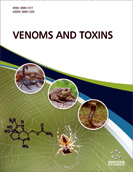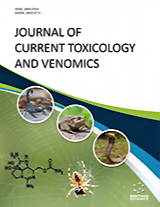Abstract
Introduction: The health challenges associated with cassava products as a common staple food for approximately 70 % of Africans and part of Asia pose a looming danger due to Bacillus enterotoxins’ presence in the processing environment.
Objective: This study investigated the presence of enterotoxigenic genes, namely, Bacillus cereus enterotoxin T (bceT), hemolysin bl (hblC, hblD), and non-haemolytic enterotoxin (nheA, nheB, and nheC) from Bacillus species isolated from soil of cassava processing environment.
Methods: Soil samples from 20 cassava processing sites in Ile-Ife and Modakeke, Nigeria, were collected and cultured on nutrient agar at 37ºC for 24 hours. Colonies phenotypically identified as Bacillus were identified using Bacillus-specific 16S rRNA-targeted PCR technique. Screened Bacillus spp were assessed for the presence of enterotoxigenic genes using PCR with previously reported primers.
Results: A total of 100 Bacillus isolates were selected from this study, with Bacillus macerans (33 %) showing the highest frequency of occurrence among the identified species, however, 74 isolates were molecularly confirmed as Bacillus. Amongst the 74 molecularly confirmed Bacillus isolates, 28 (37.84 %), 35 (47.30 %), and 37 (50 %) had nhe, hbl, and bceT genes, respectively. Investigation showed that 42 (56.76 %) of the Bacillus species encoded at least one of the screened enterotoxin genes.
Conclusion: The presence of these 3 sets of enterotoxin genes in Bacillus isolated from cassava processing sites calls for immediate attention as they could be pivotal in the release of toxins in cassava products, causing lethal effects via consumption. This study demonstrates the possibility of foodborne disease outbreaks in Bacillus toxin-laden cassava products processed under unhygienic conditions.
Keywords: Bacillus toxins, food safety, foodborne disease, enterotoxigenic genes, cassava, hygienic practices.
Graphical Abstract
[http://dx.doi.org/10.1007/s12571-018-0814-3]
[http://dx.doi.org/10.5897/ISABB-JFAS2020.0113]
[http://dx.doi.org/10.17226/1939]
[http://dx.doi.org/10.1111/lam.13247] [PMID: 31705681]
[http://dx.doi.org/10.1002/9781118992739.ch10a]
[http://dx.doi.org/10.1128/AEM.64.3.871-879.1998] [PMID: 9501427]
[http://dx.doi.org/10.1146/annurev-chembioeng-061010-114239] [PMID: 22468597]
[http://dx.doi.org/10.1016/S0167-7012(03)00191-X] [PMID: 14529967]
[http://dx.doi.org/10.5897/AJMR2013.6586]
[http://dx.doi.org/10.1016/j.fmrre.2004.12.005] [PMID: 15808746]
[http://dx.doi.org/10.1186/2193-1801-2-154] [PMID: 23626928]
[http://dx.doi.org/10.1128/AEM.02219-06] [PMID: 17259359]
[http://dx.doi.org/10.1111/j.1574-695X.2011.00842.x] [PMID: 22077223]
[http://dx.doi.org/10.4014/jmb.1502.02003] [PMID: 25791850]
[http://dx.doi.org/10.1128/AEM.67.9.3873-3881.2001] [PMID: 11525980]
[http://dx.doi.org/10.1111/j.1574-6976.2008.00112.x] [PMID: 18422617]
[http://dx.doi.org/10.1128/AEM.71.1.105-113.2005] [PMID: 15640177]
[http://dx.doi.org/10.3390/toxins6123326] [PMID: 25514093]
[http://dx.doi.org/10.1111/j.1462-5822.2010.01522.x] [PMID: 20731668]
[http://dx.doi.org/10.1111/j.1365-2672.2004.02371.x] [PMID: 15357730]
[http://dx.doi.org/10.1371/journal.pone.0154389] [PMID: 27104353]
[http://dx.doi.org/10.1111/j.1365-2672.2007.03550.x] [PMID: 17922831]
[http://dx.doi.org/10.1016/j.ijfoodmicro.2013.01.001] [PMID: 23376783]
[http://dx.doi.org/10.12691/ajmr-3-2-2]
[http://dx.doi.org/10.1186/s12866-017-0975-9] [PMID: 28288581]
[http://dx.doi.org/10.1128/AEM.69.4.2372-2376.2003] [PMID: 12676723]
[http://dx.doi.org/10.1590/S1517-83822013000400024] [PMID: 24688511]
[http://dx.doi.org/10.1371/journal.pntd.0003455] [PMID: 25830379]
 10
10 1
1




